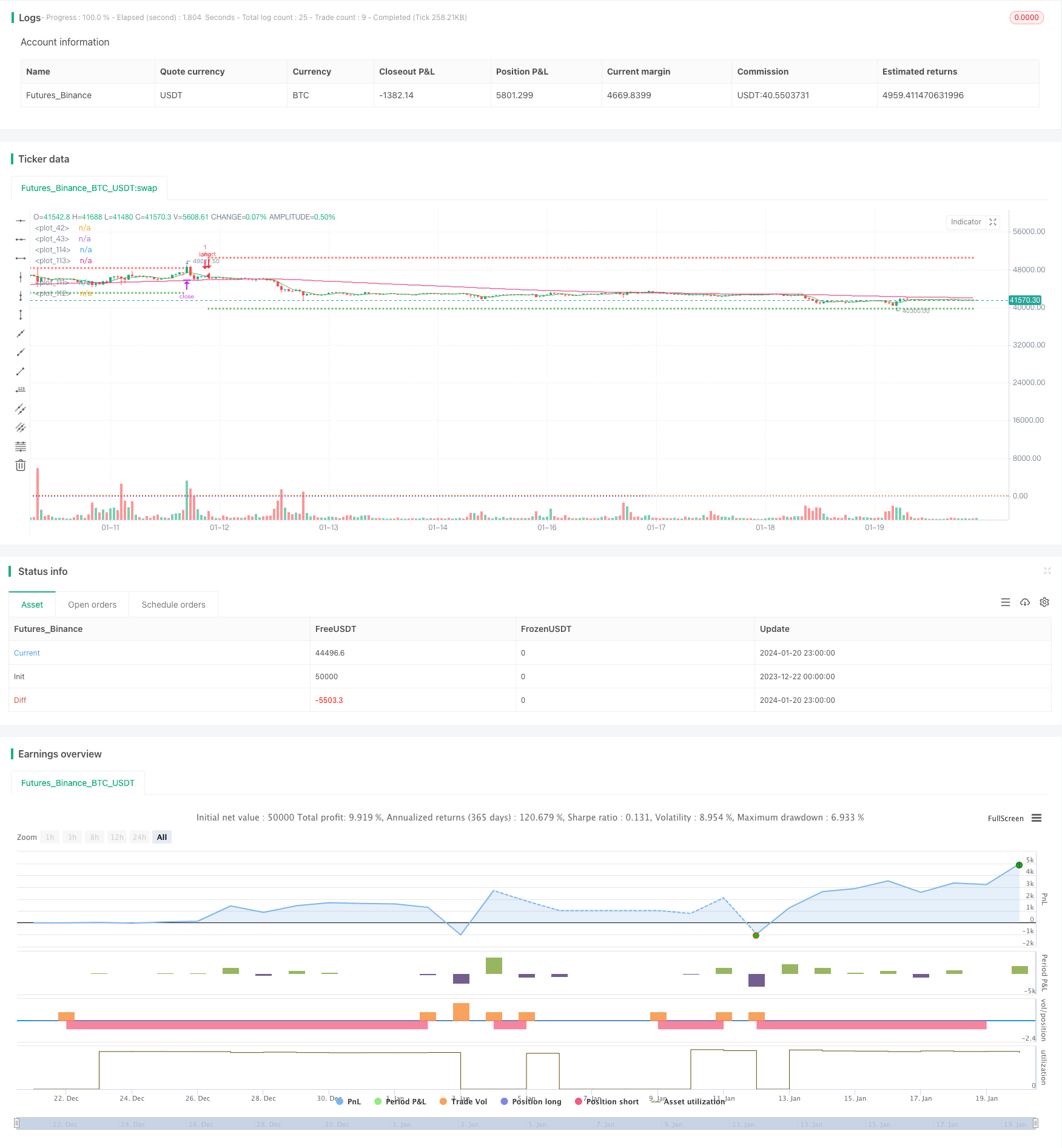
概述
这个策略结合了随机指标RSI、移动平均线SMA和加权移动平均线WMA来寻找买入卖出信号。它同时在5分钟和1小时时间框架判断趋势方向。在企稳的趋势中,当快线RSI上穿或下穿慢线时产生交易信号。
策略原理
该策略首先在1小时和5分钟两个时间框架分别计算144周期加权移动平均线WMA和5周期简单移动平均线SMA。只有当5分钟SMA在WMA之上时,才认为是多头市场。然后策略计算RSI的多空指标,以及对应的K线和D线。当K线从超买区域下穿D线时,产生卖出信号;当K线从超卖区域上穿D线时,产生买入信号。
优势分析
这是一个非常有效的趋势跟踪策略。它同时结合了两个时间框架判断趋势,非常有效地减少了错误信号。另外,它结合多种指标进行过滤,包括RSI、SMA和WMA,使信号更加可靠。通过让RSI驱动KDJ,它也修改了普通KDJ策略中容易产生的假信号问题。此外,该策略还有止损和止盈设置来锁定利润,可以有效控制风险。
风险分析
该策略最大的风险在于趋势判断错误。在行情转折点时,短期和长期平均线可能同时上翻或下翻,从而产生错误信号。此外,在震荡行情时,RSI也可能产生较多纠缠不清的交易信号。不过这些风险可以通过适当调整SMA和WMA周期以及RSI参数来减轻。
优化方向
该策略可以从以下几个方面进行优化: 1)测试不同长度的SMA、WMA和RSI,找到最佳参数组合 2)增加其他指标判断,如MACD、布林线等来验证信号可靠性 3)优化止损止盈策略,测试固定比例止损、余额滑点止损、跟踪止损等方法 4)加入资金管理模块,控制单笔投资规模和整体风险敞口 5)增加机器学习算法,通过大量回测找到有最好绩效的参数
总结
该策略充分利用了移动平均线和随机指标的优势,建立了一个较为可靠的趋势跟踪体系。通过多个时间框架和指标的验证,它能顺利捕捉中长线趋势的方向。同时止损止盈设置也让其承受了一定程度的市场震荡。不过仍有一定改进空间,如测试更多指标结合使用,引入机器学习方法寻找最优参数等。总的来说这是一个非常有前景的交易策略。
/*backtest
start: 2023-12-22 00:00:00
end: 2024-01-21 00:00:00
period: 1h
basePeriod: 15m
exchanges: [{"eid":"Futures_Binance","currency":"BTC_USDT"}]
*/
// This source code is subject to the terms of the Mozilla Public License 2.0 at https://mozilla.org/MPL/2.0/
// © bufirolas
// Works well with a wide stop with 20 bars lookback
// for the SL level and a 2:1 reward ratio Take Profit .
// These parameters can be modified in the Inputs section of the strategy panel.
// "an entry signal it's a cross down or up on
// the stochastics. if you're in a downtrend
// on the hourly time frame you
// must also be in a downtrend on the five
// minute so the five period has to be below the 144
// as long as the five period is still trading below
// the 144 period on both the hourly and the five minutes
// we are looking for these short signals crosses down
// in the overbought region of the stochastic. Viceversa for longs"
//@version=4
strategy("Stoch + WMA + SMA strat", overlay=true)
//SL & TP Inputs
i_SL=input(true, title="Use Swing Lo/Hi Stop Loss & Take Profit")
i_SwingLookback=input(20, title="Swing Lo/Hi Lookback")
i_SLExpander=input(defval=10, step=1, title="SL Expander")
i_TPExpander=input(defval=30, step=1, title="TP Expander")
i_reverse=input(false, title="Reverse Trades")
i_TStop =input(false, title="Use Trailing Stop")
//Strategy Inputs
src4 = input(close, title="RSI Source")
stochOS=input(defval=20, step=5, title="Stochastics Oversold Level")
stochOB=input(defval=80, step=5, title="Stochastics Overbought Level")
//Stoch rsi Calculations
smoothK = input(3, minval=1)
smoothD = input(3, minval=1)
lengthRSI = input(14, minval=1)
lengthStoch = input(14, minval=1)
rsi1 = rsi(src4, lengthRSI)
k = sma(stoch(rsi1, rsi1, rsi1, lengthStoch), smoothK)
d = sma(k, smoothD)
h0 = hline(80, linestyle=hline.style_dotted)
h1 = hline(20, linestyle=hline.style_dotted)
//MA
wmalen=input(defval=144, title="WMA Length")
WMA = security(syminfo.tickerid, "60", wma(close, wmalen))
SMA = security(syminfo.tickerid, "60", sma(close, 5))
minWMA = wma(close, wmalen)
minSMA = sma(close, 5)
//Entry Logic
stobuy = crossover(k, d) and k < stochOS
stosell = crossunder(k, d) and k > stochOB
mabuy = minSMA > minWMA
daymabuy = SMA > WMA
//SL & TP Calculations
SwingLow=lowest(i_SwingLookback)
SwingHigh=highest(i_SwingLookback)
bought=strategy.position_size != strategy.position_size[1]
LSL=valuewhen(bought, SwingLow, 0)-((valuewhen(bought, atr(14), 0)/5)*i_SLExpander)
SSL=valuewhen(bought, SwingHigh, 0)+((valuewhen(bought, atr(14), 0)/5)*i_SLExpander)
lTP=(strategy.position_avg_price + (strategy.position_avg_price-(valuewhen(bought, SwingLow, 0)))+((valuewhen(bought, atr(14), 0)/5)*i_TPExpander))
sTP=(strategy.position_avg_price - (valuewhen(bought, SwingHigh, 0) - strategy.position_avg_price))-((valuewhen(bought, atr(14), 0)/5)*i_TPExpander)
islong=strategy.position_size > 0
isshort=strategy.position_size < 0
//TrailingStop
dif=(valuewhen(strategy.position_size>0 and strategy.position_size[1]<=0, high,0))
-strategy.position_avg_price
trailOffset = strategy.position_avg_price - LSL
var tstop = float(na)
if strategy.position_size > 0
tstop := high- trailOffset - dif
if tstop<tstop[1]
tstop:=tstop[1]
else
tstop := na
StrailOffset = SSL - strategy.position_avg_price
var Ststop = float(na)
Sdif=strategy.position_avg_price-(valuewhen(strategy.position_size<0
and strategy.position_size[1]>=0, low,0))
if strategy.position_size < 0
Ststop := low+ StrailOffset + Sdif
if Ststop>Ststop[1]
Ststop:=Ststop[1]
else
Ststop := na
//Stop Selector
SL= islong ? LSL : isshort ? SSL : na
if i_TStop
SL:= islong ? tstop : isshort ? Ststop : na
TP= islong ? lTP : isshort ? sTP : na
//Entries
if stobuy and mabuy and daymabuy
strategy.entry("long", long=not i_reverse?true:false)
if stosell and not mabuy and not daymabuy
strategy.entry("short", long=not i_reverse?false:true)
//Exit
if i_SL
strategy.exit("longexit", "long", stop=SL, limit=TP)
strategy.exit("shortexit", "short", stop=SL, limit=TP)
//Plots
plot(i_SL ? SL : na, color=color.red, style=plot.style_cross)
plot(i_SL ? TP : na, color=color.green, style=plot.style_cross)
plot(minWMA)
plot(minSMA, color=color.green)